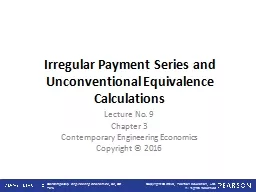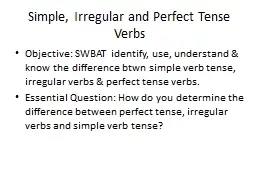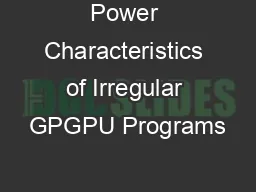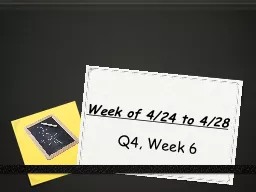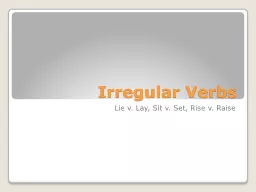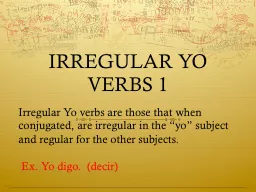PPT-Irregular Payment Series and Unconventional
Author : mitsue-stanley | Published Date : 2017-09-09
Equivalence Calculations Lecture No 9 Chapter 3 Contemporary Engineering Economics Copyright 2016 Example 323 Uneven Payment Series How much do you need to deposit
Presentation Embed Code
Download Presentation
Download Presentation The PPT/PDF document "Irregular Payment Series and Unconventio..." is the property of its rightful owner. Permission is granted to download and print the materials on this website for personal, non-commercial use only, and to display it on your personal computer provided you do not modify the materials and that you retain all copyright notices contained in the materials. By downloading content from our website, you accept the terms of this agreement.
Irregular Payment Series and Unconventional: Transcript
Equivalence Calculations Lecture No 9 Chapter 3 Contemporary Engineering Economics Copyright 2016 Example 323 Uneven Payment Series How much do you need to deposit today P to withdraw 25000 at . MCLM : 1 | Page ANNEXURE 5 UNAUTHORISED, IRREGULAR, FRUITLESS AND WASTEFUL EXPENDITURE POLICY MOGALE CITY LOCAL MUNICIPALITY MCLM : UNAUTHORIZED, IRREGULAR, FRUITLESS AND WASTEFUL EXPENDITURE POL . and. idealized glass . Shin-. ichi. . Sasa. (. Kyoto University). . . . . . Objective: SWBAT identify, use, understand & know the difference . btwn. simple verb tense, irregular verbs & perfect tense verbs.. Essential Question: How do you determine the difference between perfect tense, irregular verbs and simple verb tense?. The Future Tense. You can express the future tense in Spanish in three ways. . One way is using the . present. tense with a time expression.. El . tren. . sale. a . las. dos.. The Future Tense. Another way is by using . Data Provided by Central Command. As Of. October 18, 2006. Security Expansion. Decreased Population. Mass Civil Conflict. Significant . Routine. Significant . Irregular. Assassinations. Significant. Leader Influence. Jared . Coplin. and Martin . Burtscher. Department of Computer Science. 1. Introduction. GPU-based accelerators. Used in high-performance computing. Spreading in PCs and handheld . devices. 2. Power Characteristics of Irregular GPGPU Programs . something to write with. your . apuntes. . amarillos. Irregular adjectives…. Irregulars: older & younger. Do you remember how to say ‘older’ & ‘younger’ from last year?. Mili. . es. Q4, Week 6. Week. . 6. Exorbitant. Irreverent. Pompous. Unconventional. EXORBITANT. While the painters charged us an . exorbitant. fee, they did very little work. .. . . EXORBITANT. Unreasonably expensive. Human Smuggling and Development. Frank . Laczko. Head, Migration Research Division, . International Organization for . Migration. International . Metropolis . Conference, . 9 . – . 13 September 2013, . Lie . v. . Lay, Sit . v. . Set, Rise . v. . Raise. Irregular Verbs. What makes a verb irregular?. Irregular verbs do not follow the rules when it comes to conjugations in verb tense.. We all know the basics of making a verb past tense– just add “-. The. Rise of Unconventional. Mark Lenko, . B.Sc., B.A., . M.Ec. ., . P.Eng. . . Managing Director and Engineering Director. 2017 CAPL Conference. Disclaimer. Disclaimers. The information contained herein has been prepared solely for information purposes and is not intended to be used for trading or investment purposes or as an offer to sell or the solicitation of an offer to buy any security or financial product. The information has been compiled by Canadian Discovery from internal sources as well as prepared from various public and industry sources that we believe are reliable, but no representation or warranty, expressed or implied is made by Canadian Discovery, its affiliates or any other person as to the accuracy or completeness of the information. Such information is provided with the expectation that it will be read as part of a mosaic of analyses and should not be relied upon on a stand-alone basis. Past performance should not be taken as an indication or guarantee of future performance, and Canadian Discovery makes no representation of warranty regarding future performance. The opinions expressed in this report (presentation) reflect the judgment of Canadian Discovery as of the date of this report and are subject to change without notice. This report (presentation) is not an offer to sell or a solicitation of an offer to buy any securities. To the full extent provided by law, neither Canadian Discovery nor any of its affiliates, nor any other person accepts any liability whatsoever for a direct or consequential loss arising from any use of this report (presentation) or the information contained herein. As in all aspects of oil and gas evaluation, there are uncertainties in the interpretation of engineering, reservoir and geological data: therefore, the recipient should rely solely on its own independent investigation, evaluation, and judgment with respect to the information contained herein and any additional information provided by Canadian Discovery or its representatives. All trademarks, service marks, and trade names not owned by Canadian Discovery are the property of their respective owners. . Bin . Ren. Advisor: Dr. . Gagan. . Agrawal. 4/6/2014. 1. Streaming SIMD Extension. Motivation. 4/6/2014. 2. Various emerging parallel architectures. Intel . . SSE. 1999. Intel . . SSE3. 2004. Yo. verbs are those that when conjugated, are irregular in the “. yo. ” subject and regular for the other subjects. . . Ex. . Yo. . digo. . (. decir. ) . Irregular . Yo. Verbs 1. decir. =to say/tell. TreadPattern Tire Pro�le Vehicle Tire Irregular Wear Tread Pattern Tire Pro�le Vehicle
Download Document
Here is the link to download the presentation.
"Irregular Payment Series and Unconventional"The content belongs to its owner. You may download and print it for personal use, without modification, and keep all copyright notices. By downloading, you agree to these terms.
Related Documents

